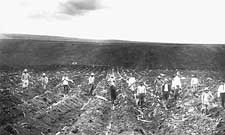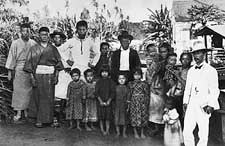 Thousands of Japanese responded to the sugar industry's call for labor |
On February 8, 1885, 943 immigrant laborers from Japan stepped from the gangplank of the steamship City of Tokio onto the dock at Honolulu Harbor. To these young workers and those who followed them from the small farms and villages of Hiroshima, Yamaguchi, Kumamoto, and Okinawa, this island kingdom in the middle of the Pacific was Tenjiku. Heaven.
King Kala-kaua himself came to the dockside to welcome these laboring representatives of Nippon; ceremonies and celebrations marked the day's festivities as dances, songs, and even sumo wrestling were enjoyed by the newcomers and their hosts.
![]()
![]()

![]()
Thousands of Japanese responded to the sugar industry's call for labor
Not all of the subsequent Japanese who would venture to Hawai'i would be given such a festive welcome and it was not long before they all realized that the land of Tenjiku was short on gold and long on labor. For the Hawaiian sugar and pineapple plantations of the early twentieth century were an expanding agricultural industry that needed thousands of workers, to plant, hoe, fertilize, irrigate, weed, burn, cut, harvest, load and mill the thousands of tons of produce that brought in the millions of dollars of profits.
Between 1885 and 1907, thousands of Japanese came to Hawai'i in numbers so great that by 1897 Japanese constituted the largest single ethnic group in the Islands. In 1888, there were 6,420 Japanese in Hawai'i; in 1890, 12,360; in 1896, 24,407; in 1900, 61,111. By 1900, the Japanese composed nearly 40 percent of the population in Hawai'i.
 Matchmakers used photographs to introduce prospective couples |
Besides, the plantation camps were only temporary homes. After a few years of work, they expected to return to their beloved homeland. The real disappointment came not from the work or the poor living conditions, but from the meager wages of the plantation that destroyed these dreams of triumphantly returning to their villages as rich, successful sojourners. There was little wealth obtainable from earning less than fifty cents a day. The years passed and the promise of Tenjiku faded, as did the hope of ever returning to Japan. Better to be a stranger in this foreign land than to face the shame of being a failure in your own family village.
 Laborers prepare canefields for planting |
Letters were written home requesting that their parents contact the matchmakers in the village so that respectable women could be found for the distant sojourners. Pictures of the men were taken by professional photographers who often used the same worn suit over and over so that these laborers looked a little more distinguished. The portraits were then tucked into the letters. In time they would receive from Japan the exciting news that a bride had been found and if approved, arrangements would be made to send the young woman across the seas to this foreign land. Inside the envelope would also be the photograph of the prospective bride.
 With the birth of children came thoughts of Hawai'i as home |
The period of summoning families - of arranged "picture brides" and the sending for close relatives, wives and children - has been called yobiyose jidai. During the peak years between 1911 and 1919, 9,500 picture brides bolstered the Islands' female population. And, as might be expected, this early period of stabilization of the Japanese family coincided with a high birth rate. The birth of the second generation, the nisei, in effect established the identity of the first generation, the issei. They were no longer single sons of farmers seeking wild dreams of wealth - they were responsible parents who were beginning to view the Hawaiian Islands not as a failed dream or a hostile land, but as a new home. The establishment of families was soon followed by the growth of Buddhist and Christian churches, a variety of language newspapers, and self-help organizations that served the needs of the immigrant community.
 A plantation family celebrates Boy's Day |
The luna, or boss, on the plantation was invariably Portuguese or haole and many luna were not disinclined to use a whip or physical force to insure the productivity of their laborers. Such treatment was an insult to a people proud of their heritage and dignity. Most importantly, in 1907 labor immigration to the United States from Hawai'i had been prohibited so that very few alternatives were left open to the immigrants in the islands. Low, demeaning plantation wages could no longer be escaped by immigrating to the states where there were opportunities in agriculture and fishing. Return to Japan with no money or savings was impossible without losing face.
The only route open to them was to challenge the powerful plantation oligarchy and demand higher wages and more decent living conditions. Going up against the full might of the power structure, being aliens in what was often a hostile environment, the decision to strike took a courage and determination of spirit that was noble from almost any perspective.
 Issei (first generation) group and the next generation |
Although the strike was broken, the strikers had won a few concessions in better working conditions. But by 1920, labor unrest had again fermented among the Japanese and with the assistance of some Filipino labor leaders, another major plantation strike was initiated. Again, the community was thrown into turmoil as Honolulu swelled with striking Japanese workers who had been evicted from the plantations.
The 1920 strike was another bitter conflict that demonstrated to a great many Japanese immigrants that the plantations were a system that offered them limited futures. Thousands of laborers moved into the urban areas of Hawai'i and began to enter the skilled trades, small businesses and other non-agricultural fields that gave them economic freedom and opportunity. Neighborhood pockets were created in Kaka'ako, Kapa-lama, Mo-'ili'ili and Kaimuki- as the Japanese community found ethnic solidarity in their familiar associations. Clothing, food, customs, newspapers, stores and daily lifestyles of the town of Honolulu began to clearly reflect the Asian character and influence of the Japanese immigrants and their children.
Understandably, the family which the issei created in Hawai'i would be fashioned by roots in the rural villages of Meiji Japan. Among the Japanese attitudes transmitted by the issei and portrayed in the PICTURE BRIDE film were shikata ga nai ("it can't be helped") and ganbare (inner strength). Both offered a deep sense of spiritual succor in the face of racial discrimination and social disappointment.
The immigrant families also tried to maintain Japanese values such as filial piety, obligation to community and authority (on), reciprocal obligation (giri), and a fear of shame (haji). Education was highly valued as were hard work, perseverance, and frugality - the Bushido Code of the samurai. And most important, instilled in the nisei was the drive for success, seiko - a success measured in the attainment of social and economic prestige.
If one worked hard, saved, sacrificed and gathered strength from one's cultural roots, then material, social and spiritual well-being would be possible. Through their efforts to establish homes in the Islands and to improve the quality of their lives in the face of powerful countervailing forces, the issei provided a sound base upon which succeeding generations could grow.
Dennis M. Ogawa is a professor of American Studies at the University of Hawai'i at Mānoa whose books include Jan Ken Po: The World of Hawaii's Japanese Americans and Kodomo No Tame Ni: The Japanese Experience in Hawaii. He is also president of Nippon Golden Network (NGN), a Japanese language cable network based in Honolulu.
Glen Grant is director of American Studies at Tokai International College in Honolulu, where he coordinates a program of Hawaiian multicultural studies. He is the author of Obake: Ghost Stories in Hawai'i, as well as numerous other works, many in collaboration with Dennis Ogawa.